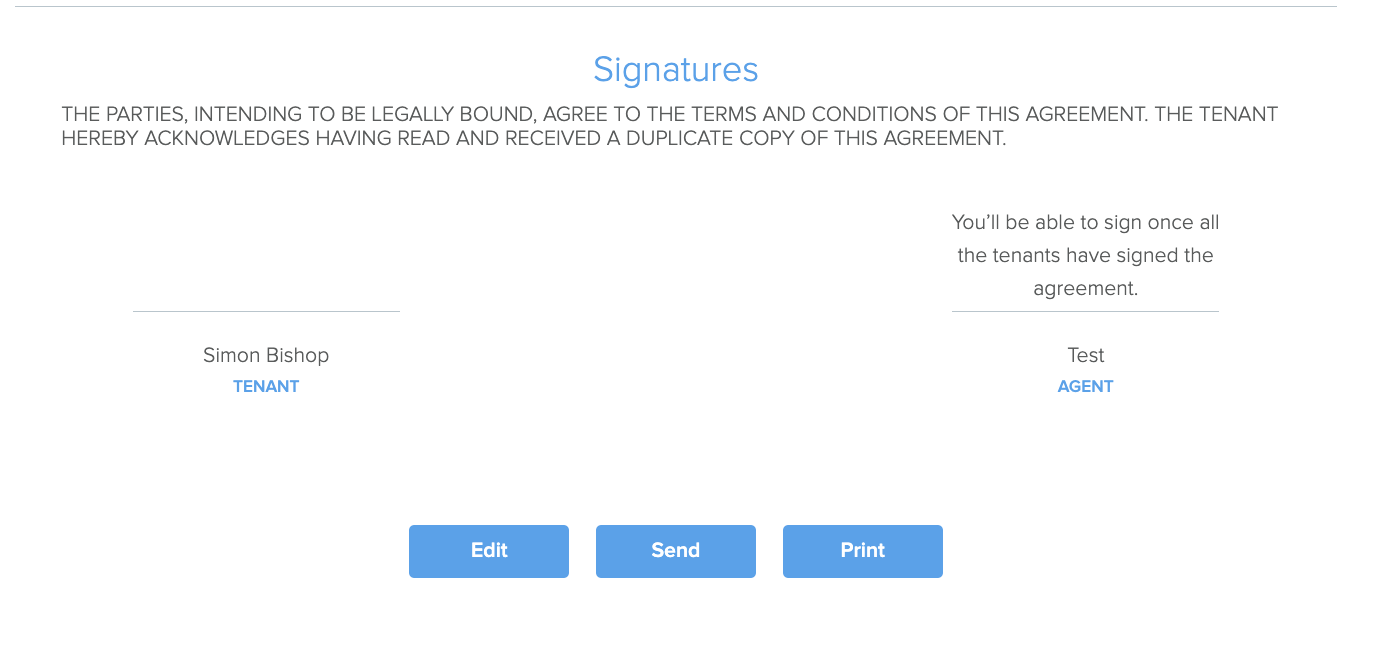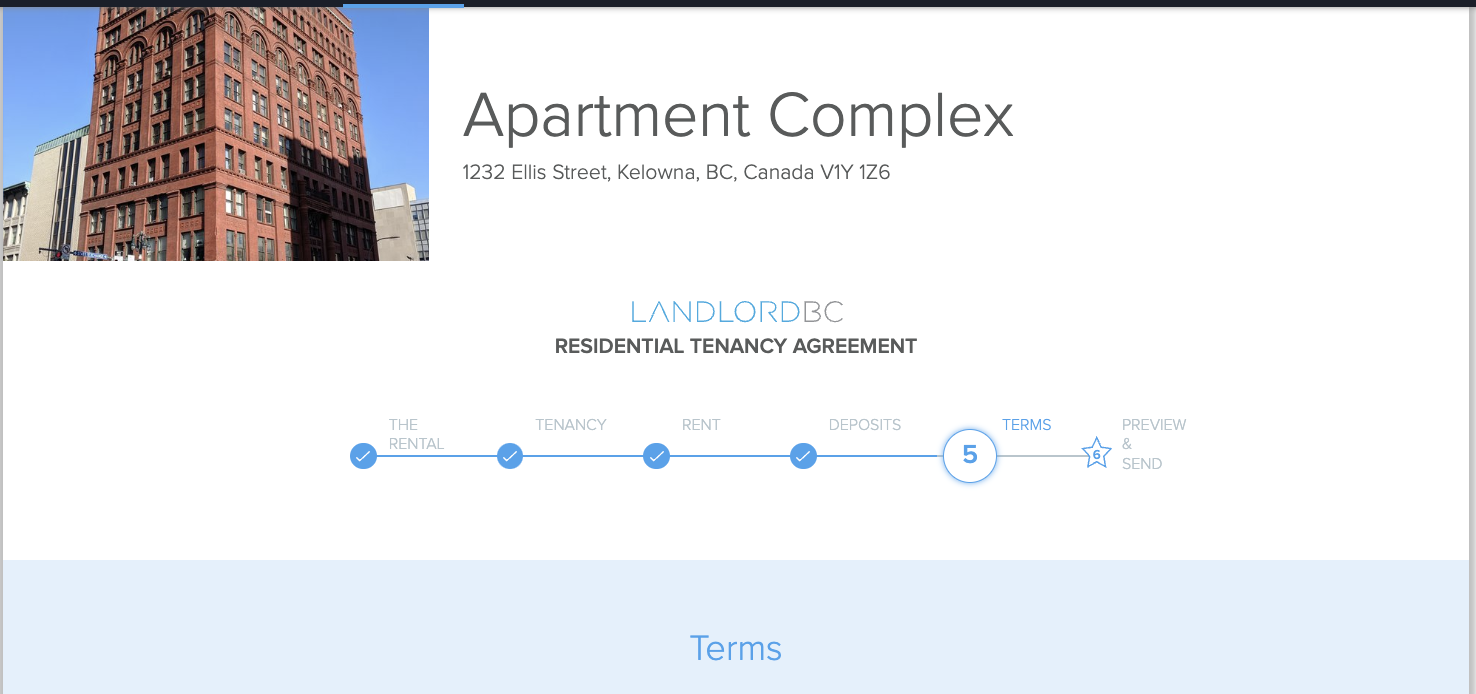Pendo Support
- /
- /
- /
How do I create a Digital LLBC Lease in Pendo?
1. To create a Digital Lease Agreement in Pendo, you must first add a Lease Summary.
2. After saving the Lease, choose to ‘Create a Lease Agreement’.
3. Complete all 6 steps of Pendo’s Digital Lease Agreement.
Section One
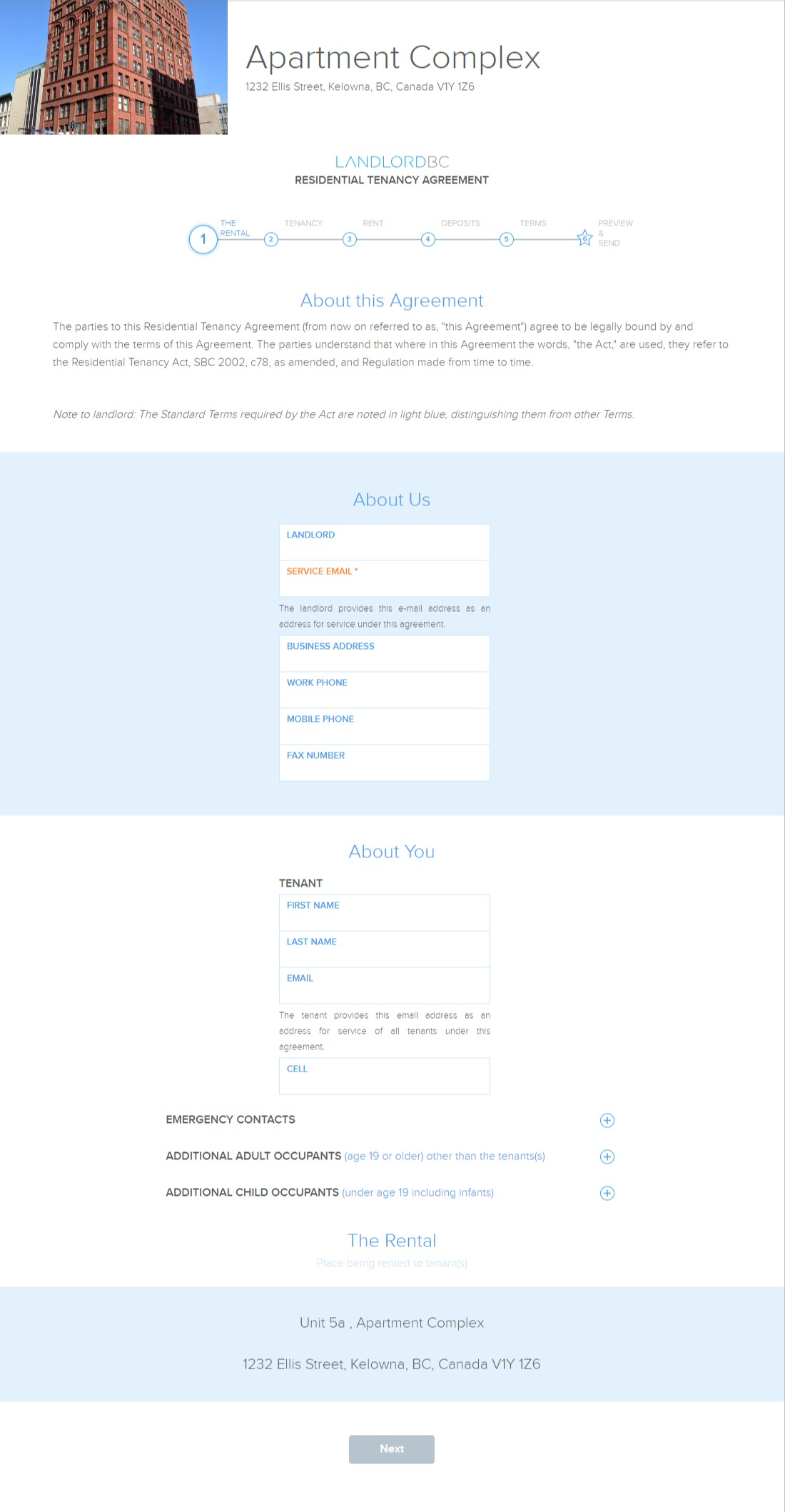
Section Two – Month to month tenancy
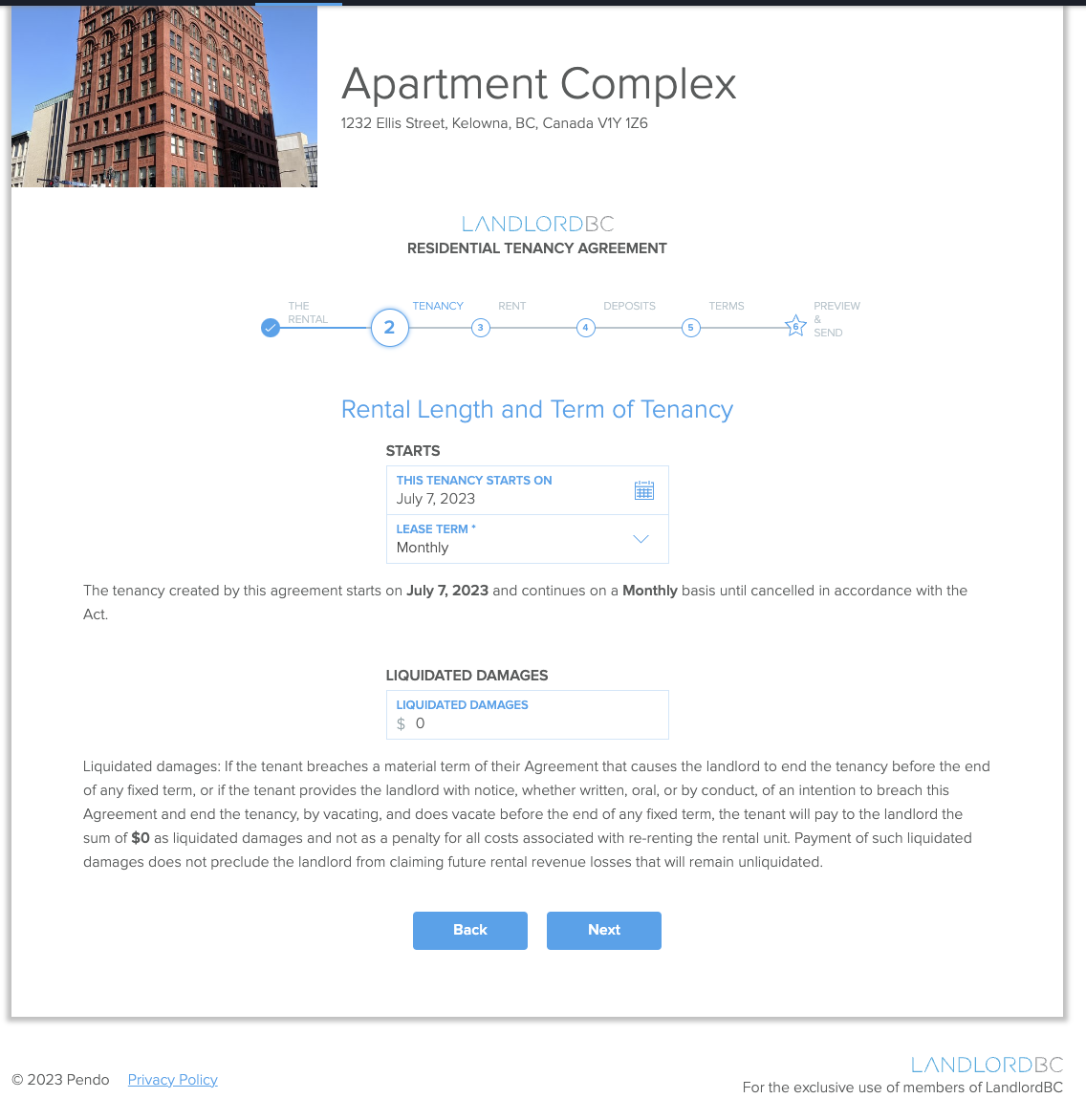
Section Two – Fixed Length converting to Month to Month
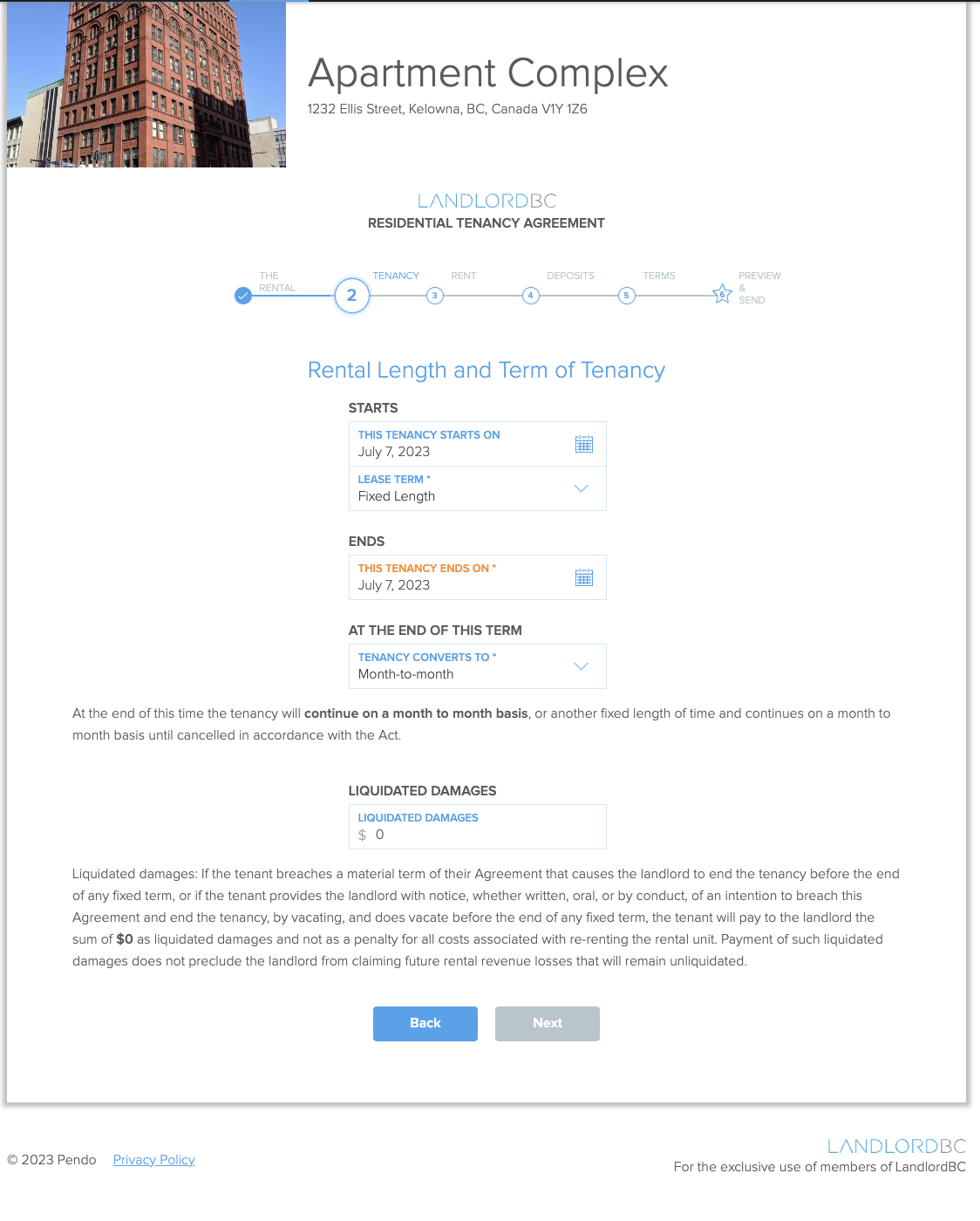
Section Two – Fixed Length – Tenant must move out at end of term
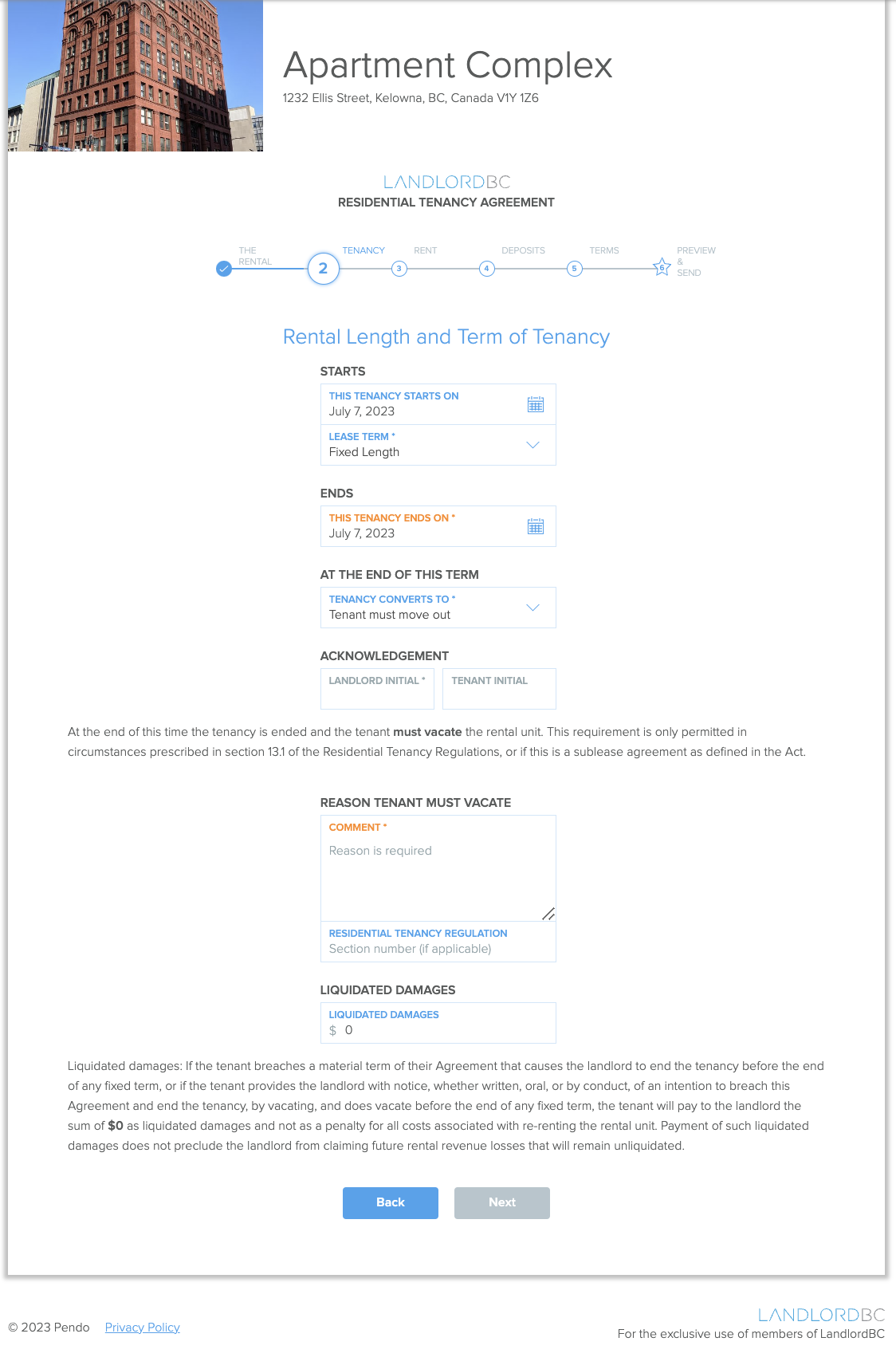
Section Three
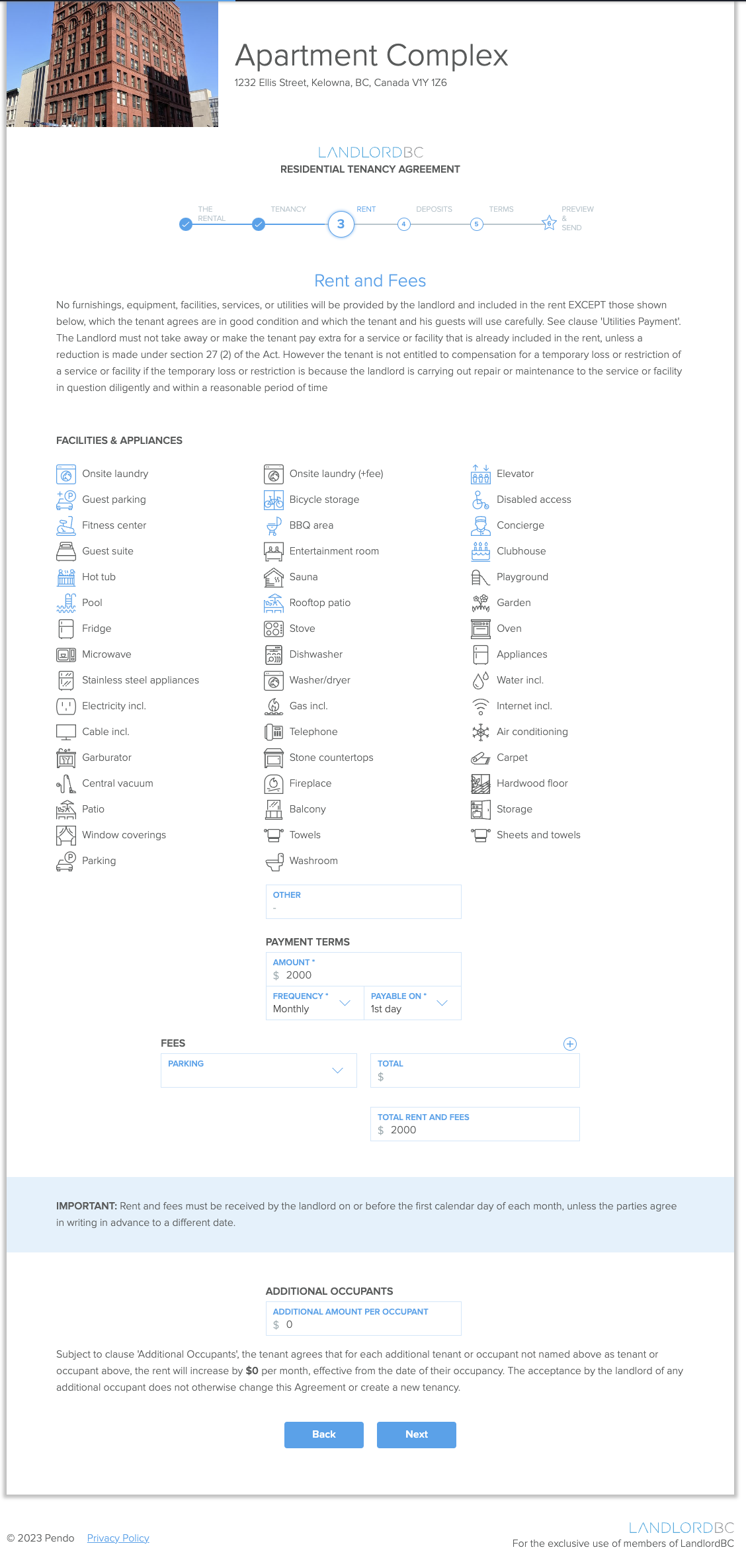
Section Four
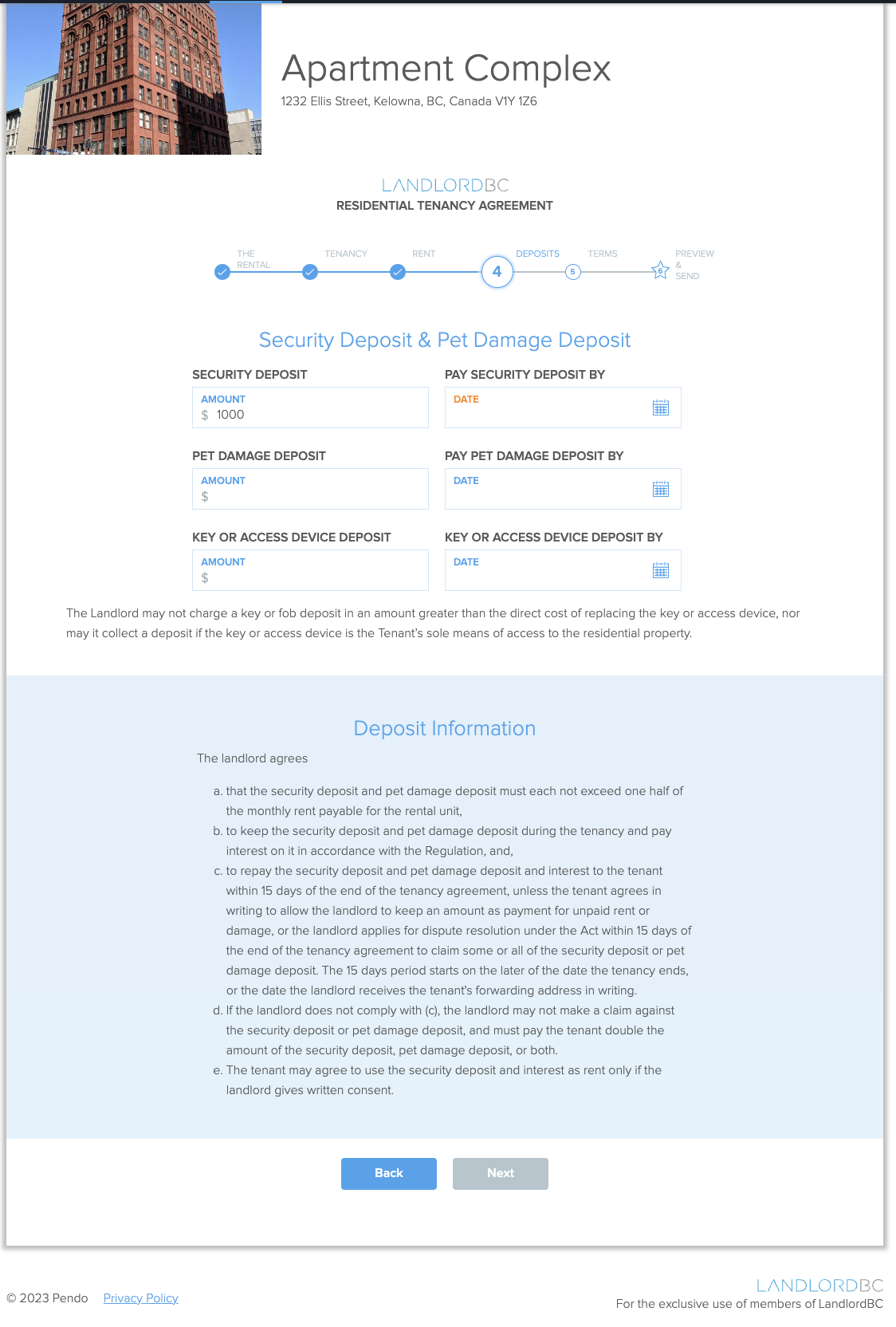
Section Five
-
CONDITION INSPECTIONS. In accordance with sections 23 and 35 of the Act and Part 3 of the Regulation, the landlord and tenant must inspect the condition of the rental unit together when the tenant is entitled to possession, when the tenant starts keeping a pet during the tenancy if a condition inspection was not completed at the start of the tenancy, and at the end of the tenancy. The landlord and tenant may agree on a different day for the condition inspection. The right of a tenant to return of a security or pet damage deposit or both, or the right of a landlord to claim against a security or pet damage deposit or both for damage to residential property is extinguished if that party does not comply with sections 23 and 35 of the Act.
-
PAYMENT OF RENT. The tenant must pay the rent on time, unless the tenant is permitted under the Act to deduct from the rent. If the rent is unpaid, the landlord may issue a notice to end a tenancy to the tenant, which may take effect not earlier than 10 days after the date the tenant receives the notice. The landlord must give the tenant a receipt for rent paid in cash. The landlord must return to the tenant on or before the last day of the tenancy any post-dated cheques for rent that remain in the possession of the landlord. If the landlord does not have a forwarding address for the tenant and the tenant has vacated the rental unit without notice to the landlord, the landlord must forward any post-dated cheques for rent to the tenant when the tenant provides a forwarding address in writing.
- ARREARS. Late payment, returned or non-sufficient funds (N.S.F.) cheques are subject to an administrative fee of not more than $25.00 each, plus the amount of any service fees charged by a financial institution to the landlord. Although these fees are payable by the tenant to the landlord, failure to pay the rent on the due date is a breach of a material term of this Agreement. The obligation of the tenant under this Agreement and by law requires the rent to be paid on the date that it is due. For example, an excuse that the tenant does not have the rent money or will not have the rent money until a later date is not an acceptable excuse in law.
- UTILITIES PAYMENT. Utilities that are not included in the rent or are not paid to the landlord are the responsibility of the tenant who must apply for hook up and must maintain current payment of the utility account. The discontinuation of utility service resulting from the tenant’s cancellation or failure to maintain payment of his utility account is a breach of a material term of this Agreement. The landlord has the right to end the tenancy if the tenant fails to correct the breach within a reasonable time after receiving written notice to do so. Any utilities charges to be paid to the landlord that remain unpaid more than 30 days after the tenant receives a written demand for payment will be treated as unpaid rent and the landlord may issue a Notice to End Tenancy. The Tenant is responsible to pay for any costs relating to utilities under this section, including the cost of reconnection fees, and is furthermore responsible to pay for any damages to the rental unit or to the Tenant’s possessions resulting from utility interruption, or the Tenant’s failure to activate a utility account.
-
RENT INCREASES. Once a year the landlord may increase the rent for the existing tenant. The landlord may only increase the rent 12 months after the date that the existing rent was established with the tenant or 12 months after the date of the last legal rent increase for the tenant, even if there is a new landlord or a new tenant by way of an assignment. The landlord must use the approved Notice of Rent Increase form available from any Residential Tenancy Branch or ServiceBC Centre. The landlord must give the tenant 3 whole months notice, in writing, of a rent increase. For example, if the rent is due on the 1st of the month and the tenant is given notice any time in January, including January 1st, there must be 3 whole months before the increase begins. In this example, the months are February, March and April, so the increase would begin on May 1st. The landlord may increase the rent only in the amount set out by the Regulation. If the tenant thinks the rent increase is more than is allowed by the Regulation, the tenant may talk to the landlord or contact the Residential Tenancy office for assistance. Either the landlord or the tenant may obtain the percentage amount prescribed for a rent increase from the Residential Tenancy office.
The landlord and tenant may agree in writing to a rent increase greater than the percentage amount permitted by the Regulation.
- ADDITIONAL OCCUPANTS. Only persons listed as Tenants, Adult Occupants or Minor Occupants may occupy the rental unit or residential property. A person not listed above who, without the landlord’s prior written consent, resides in the rental unit or on the residential property in excess of fourteen cumulative days in a calendar year will be considered to be occupying the rental unit or residential property contrary to this Agreement. If the tenant anticipates an additional occupant, the tenant must apply in writing for approval from the landlord for such person to become an authorized occupant. Failure to obtain the landlord’s written approval is a breach of a material term of this Agreement, giving the landlord the right to end the tenancy on proper notice. The tenant will cooperate with the landlord’s reasonable requests for information about any person who appears to be an occupant of the rental unit.
- USE OF RENTAL UNIT. The tenant and his guests must use the rental unit for private residential purposes only and not for any illegal, unlawful, commercial, political or business purposes including but not limited to home sharing services. No public meetings or assemblies may be held in the rental unit. No business or commercial advertising may be placed on or at the rental unit or the residential property. When the landlord supplies window coverings, the tenant’s drapes and curtains may not be used without the landlord’s prior written consent. The tenant will not make or cause any structural alteration to be made to the rental unit or residential property. Painting, papering, or decorating of the rental unit or residential property may be done only with the landlord’s prior written consent and with landlord approved colours. Hooks, nails, tapes, or other devices for hang pictures or plants, or for affixing anything to the rental unit or residential property will be of a type approved by the landlord and used only with the landlord’s prior written consent. The tenant may not install a washer, dryer, dishwasher, freezer, or similar equipment without the landlord’s prior written consent. Any appliance or equipment supplied by the landlord must not be repaired or removed without the landlord’s prior written consent. The tenant must ensure that the rental unit is appropriately ventilated, exhaust fans are regularly used, and must follow reasonable housekeeping practices, to minimize the presence or accumulation of moisture, thus preventing the occurrence of mould or mildew.
- MOVING. The tenant’s property must be moved in or out of the residential property through designated doors, at the risk of the tenant. The tenant will be liable for any costs of moving, including any costs resulting from injury, or from damage to the tenant’s property, the residential property, or the rental unit. If the tenant requests and the landlord agrees to a move to a different rental unit within the residential property, the landlord may charge the tenant the greater of $15 or 3% of the rent in the tenant’s current rental unit as a one-time moving fee.
-
ASSIGN OR SUBLET. The tenant may assign or sublet the rental unit to another person with the written consent of the landlord. If this tenancy agreement is for a fixed length and has 6 months or more remaining in the term, the landlord must not unreasonably withhold consent. Under an assignment a new tenant must assume all of the rights and obligations under this tenancy agreement, at the same rent. The landlord must not charge a fee or receive a benefit, directly or indirectly, for giving this consent. If a landlord unreasonably withholds consent to assign or sublet or charges a fee, the tenant may apply for dispute resolution under the Act.
- CONDUCT. In order to promote the safety, welfare, enjoyment, and comfort of other occupants and tenants of the residential property and the landlord, the tenant or the tenant’s guests must not disturb, harass, or annoy another occupant of the residential property, the landlord, or a neighbour. In addition, noise or behaviour, which in the reasonable opinion of the landlord may disturb the comfort of any occupant of the residential property or other person, must not be made by the tenant or the tenant’s guests, nor must any noise be repeated or persisted after a request to discontinue such noise or behaviour has been made by the landlord. The tenant or the tenant’s guests must not cause or allow loud conversation or noise to disturb the quiet enjoyment of another occupant of the residential property or other person at any time, and in particular between the hours of 10:00 p.m. and 9:00 a.m. If any tenant or tenant’s guest causes another tenant to vacate his rental unit because of such noise or other disturbance, harassment, or annoyance or because of illegal activity by the tenant or tenant’s guest, the tenant must indemnify and save harmless the landlord for all costs, losses, damages, or expenses caused thereby. The landlord may end the tenancy pursuant to the Act as one of his remedies.
PETS. Unless specifically permitted in writing in advance by the landlord, the tenant must not keep or allow on the residential property any animal, including a dog, cat, reptile, or exotic animal, domestic or wild, fur bearing or otherwise. Where the landlord has given his permission in advance in writing, the tenant must ensure that the pet does not disturb any person in the residential property or neighbouring property, and further the tenant must ensure that no damage occurs to the rental unit or residential property as a result of having or keeping the pet. This is a material term of this Agreement. If any damage occurs caused by the pet, the tenant will be liable for such damage and will compensate the landlord for damages, expenses, legal fees and/or any other reasonable costs incurred by the landlord. Further, if the landlord gives notice to the tenant to correct any breach and the tenant fails to comply within a reasonable time, the landlord has a right to end the tenancy along with making the appropriate claims against the tenant. Having regard to the potential safety issues, noise factors, health requirements, and mess, the tenant will not encourage or feed wild birds or animals at or near the residential property.
Any term in this tenancy agreement that prohibits or restricts the size of a pet, or that governs the tenant’s obligations regarding the keeping of a pet on the residential property is subject to the rights and restrictions under the Guide Animal Act, Service Dog Act.
- OCCUPANTS AND INVITED GUESTS. The landlord must not stop the tenant from having guests under reasonable circumstances in the rental unit. The landlord must not impose restrictions on guests and must not require or accept any extra charge for daytime visits or overnight accommodation of guests. Despite subsection (2) of this section but subject to section 27 of the Act [terminating or restricting services or facilities], the landlord may impose reasonable restrictions on guests’ use of common areas of the residential property. If the number of occupants in the rental unit is unreasonable, the landlord may discuss the issue with the tenant and may serve a notice to end tenancy. If the number of occupants in the rental unit is unreasonable, the landlord may discuss the issue with the tenant and may serve a notice to end a tenancy. Disputes regarding the notice may be resolved by applying for dispute resolution under the Residential Tenancy Act.
- STORAGE. All property of the tenant kept on the residential property must be kept in safe condition in proper storage areas and is at the tenant’s risk for loss, theft, or damage from any cause whatsoever. Hazardous or dangerous items must not be brought onto or kept on or in the residential property or rental unit. It is a material term of this Agreement that items stored inside the rental unit must be limited in type and quantity so as not to present a potential fire or health hazard, or to impede access to, egress from or normal movement within any area of the rental unit.Vehicles. Only vehicles listed in the tenancy application and no other vehicles may be parked, but not stored, on the residential property. Vehicles must not leak fluids and must be in operating condition, currently licensed, and insured for on-road operation. Motor vehicle or other repairs must not be done in the rental unit or on the residential property. The tenant and the tenant’s guest and occupants must remove their vehicle(s) from their assigned parking stall(s) when requested to do so in writing by the landlord so that it may perform repair and maintenance to the parking stalls in question. On request, the Tenant will provide evidence that the Tenant’s vehicle is insured.
Bicycles. Bicycles are to be stored in designated areas only. They must not be kept, left, or stored on a balcony or in a hallway. They must not be moved through a lobby or hallway, or placed in an elevator.
- LIQUID FILLED ITEMS. The tenant must not bring in to the rental unit or on the residential property any waterbed, aquarium, or other property that can be considered to be liquid filled, without the landlord’s prior written consent. The landlord’s consent will be subject to the tenant providing the landlord with written evidence that the tenant has in place tenant liability insurance with a minimum coverage of $1,000,000.
- WASTE MANAGEMENT. Garbage, waste, boxes, papers, or recyclable materials must not be placed or left in hallways, a parking area, driveway, patio, or other common area of the residential property, except those areas designated for disposal. All garbage must be drained, bagged or wrapped, and tied securely before being placed in a chute or approved receptacle. Spillage must be cleaned up immediately by the person responsible. Any large item to be discarded, such as furniture, must not be abandoned or placed in garbage collection areas, but must be removed from the residential property by the tenant at the tenant’s expense. The tenant must comply with the residential property recycling methods.
- CARPETS AND WINDOW COVERINGS. The tenant is responsible for periodic cleaning of carpets and window coverings provided by the landlord. While professional cleaning is recommended at all times, if the carpets and window coverings are new or professionally cleaned at the start of the tenancy, the tenant will pay for professional cleaning at the end of the tenancy.
- FLOORS. All non-carpeted floors must be kept clean and properly cared for by the tenant. The tenant will, within one month of the commencement of this tenancy, carpet all traffic areas that were previously bare floor, to the landlord’s reasonable satisfaction. Any furniture located on bare floor must have protective devices on the base or legs to protect the floor from damage.
- COMMON AREAS. The tenant must not misuse or damage common areas of the residential property, but must use them prudently and safely and must conform to all notices, rules, or regulations posted on or about the residential property concerning the use of common areas, including restriction of their use to tenants only and restriction on use by children. All such use will be at the sole risk of the tenant or the tenant’s guests.
- OUTSIDE. Rugs, mops, rags, and dusters must not be shaken out of windows, doors, or in common areas of the residential property. Nothing may be thrown from or placed on, hung on, or affixed to the inside or outside of windows, doors, balconies, or the exterior parts of the residential property. An awning, antenna, satellite dish, cable, or wire must not be installed on the residential property. A barbecue must not be used on or in the rental unit or stored on a balcony without the prior written consent of the landlord. A chiminea or outdoor wood-burning stove may not be used without the landlord’s prior written consent.
-
REPAIRS. Landlord’s obligations: The landlord must provide and maintain the residential property in a reasonable state of decoration and repair, suitable for occupation by a tenant. The landlord must comply with health, safety, and housing standards required by law. If the landlord is required to make a repair to comply with the above obligations, the tenant may discuss it with the landlord. If the landlord refuses to make the repair, the tenant may apply for dispute resolution under the Act for the completion and costs of the repair.
Tenant’s obligations: The tenant must maintain reasonable health, cleanliness, and sanitary standards throughout the rental unit and the other residential property to which the tenant has access. The tenant must take the necessary steps to repair damage to the residential property caused by the actions or neglect of the tenant or a person permitted on the residential property by that tenant. The tenant is not responsible for repairs for reasonable wear and tear to the residential property. If the tenant does not comply with the above obligations within a reasonable time, the landlord may discuss the matter with the tenant and may make an application for dispute resolution under the Residential Tenancy Act seeking an order of the director for the cost of repairs, serve a notice to end tenancy, or both.
Emergency Repairs: The landlord must post and maintain in a conspicuous place on the residential property, or give to the tenant in writing, the name and telephone number of the designated contact person for emergency repairs. If emergency repairs are required, the tenant must make at least two attempts to telephone the designated contact person, and then give the landlord reasonable time to complete the repairs. If the emergency repairs are still required, the tenant may undertake the repairs, and claim reimbursement from the landlord, provided a statement of account and receipts are given to the landlord. If the landlord does not reimburse the tenant as required, the tenant may deduct the cost from rent. The landlord may take over completion of the emergency repairs at any time. Emergency repairs must be urgent and necessary for the health and safety of persons or preservation or use of the residential property, and are limited to repairing major leaks in pipes or the roof, damaged or blocked water or sewer pipes or plumbing fixtures, the primary heating system, damaged or defective locks that give access to a rental unit, or the electrical systems.
- HAZARDS. The tenant will immediately notify the landlord or landlord’s contact person in the event of discovery of a fire, or the escape of water, gas or other substance starting from the rental unit or elsewhere on the residential property. The tenant will also warn any other persons on the residential property threatened by the hazard. The tenant must inform the landlord at the earliest opportunity of the presence of pests or vermin in the rental unit or on the residential property. Should pests or vermin be discovered, the tenant will cooperate with the landlord in treatment or eradication efforts.
-
APPLICATION OF THE RESIDENTIAL TENANCY ACT. The terms of this tenancy agreement and any changes or additions to the terms may not contradict or change any right or obligation under the Act or a regulation made under the Act, or any standard term. If a term of this tenancy agreement does contradict or change such a right, obligation, or standard term, the term of the tenancy agreement is void. Any change or addition to this tenancy agreement must be agreed to in writing and initialled by both the landlord and the tenant. If a change is not agreed to in writing, is not initialled by both the landlord and the tenant or is unconscionable, it is not enforceable. The requirement for agreement to change this tenancy Agreement does not apply to a rent increase given in accordance with the Act, a withdrawal of, or a restriction on, a service or facility in accordance with the Act, or a term in respect of which a landlord or tenant has obtained a Dispute Resolution Officer’s order that the agreement of the other is not required.
-
LANDLORD TO GIVE TENANCY AGREEMENT TO TENANT. The landlord must give the tenant a copy of this Agreement promptly, and in any event within 21 days of entering into this Agreement.
-
LOCKS. The landlord must not change locks or other means of access to the residential property unless the landlord provides each tenant with new keys or other means of access to the residential property. The landlord must not change locks or other means of access to a rental unit unless the tenant agrees and is given new keys. The tenant must not change locks or other means of access to common areas of the residential property, unless the landlord agrees in writing to the change, or to his rental unit, unless the landlord agrees in writing to, or a Dispute Resolution Officer has ordered, the change.
The door to the tenant’s rental unit must be kept closed and in the tenant’s absence locked. Subject to the Act no lock or security device, such as a door chain or alarm system, may be installed or changed or altered, and extra keys must not be made for any lock on the residential property or rental unit, except with the prior written consent of the landlord. The entry to any part of the residential property or rental unit by unauthorized possession of a key or otherwise by any person is a breach of a material term of this Agreement. The tenant will be responsible for any cost incurred to regain entrance to the residential property or rental unit including any damage and all necessary repairs, in the event the tenant locks himself out of the residential property or rental unit.
-
ENTRY OF RENTAL UNIT BY THE LANDLORD. For the duration of this tenancy agreement, the rental unit is the tenant’s home and the tenant is entitled to quiet enjoyment, reasonable privacy, freedom from unreasonable disturbance, and exclusive use of the rental unit. The landlord may enter the rental unit only if one of the following applies:
-
- (a) at least 24 hours and not more than 30 days before the entry, the landlord gives the tenant a written notice which states the purpose for entering, which must be reasonable, and the date and the time of the entry, which must be between 8 a.m. and 9 p.m. unless the tenant agrees otherwise;
-
- (b) there is an emergency and the entry is necessary to protect life or property;
-
- (c) the tenant gives the landlord permission to enter at the time of entry or not more than 30 days before the entry;
-
- (d) the tenant has abandoned the rental unit;
-
- (e) the landlord has an order of a Dispute Resolution Officer or court saying the landlord may enter the rental unit;
- (f) the landlord is providing housekeeping or related services and the entry is for that purpose and at a reasonable time.
The landlord may inspect the rental unit monthly in accordance with (a) above.
If a landlord enters or is likely to enter the rental unit illegally, the tenant may apply for dispute resolution under the Act to change the locks, keys, or other means of access to the rental unit and prohibit the landlord from obtaining entry into the rental unit. At the end of the tenancy the tenant must give the key to the rental unit to the landlord.
-
-
ENDING THE TENANCY. The tenant may end a monthly, weekly, or other periodic tenancy by giving the landlord at least one month’s written notice. A notice given the day before the rent is due in a given month ends the tenancy at the end of the following month. For example, if the tenant wants to move at the end of May, the tenant must make sure the landlord receives written notice on or before April 30th. This notice must be in writing and must include the address of the rental unit, include the date the tenancy is to end, be signed and dated by the tenant, and include the specific grounds for ending the tenancy, if the tenant is ending a tenancy because the landlord has breached a material term of the tenancy. If this is a fixed term tenancy and the agreement does not require the tenant to vacate at the end of the tenancy, the agreement is renewed as a monthly tenancy on the same terms until the tenant gives notice to end a tenancy as required under the Act. The landlord may end the tenancy only for the reasons and only in the manner set out in the Act and the landlord must use the approved notice to end a tenancy form available from the Residential Tenancy office. The landlord and tenant may mutually agree in writing to end this tenancy agreement at any time. The tenant must vacate the residential property by 1:00 p.m. on the day the tenancy ends, unless the landlord and tenant otherwise agree.
The tenant understands and agrees that the rental unit may be shown to potential purchasers or tenants in accordance with the Act. The tenant agrees to fully cooperate in the interest of incoming tenants.
- OVERHOLDING. If the tenant remains in possession of the rental unit after the last day of the term as set out in this Agreement, or after any other lawful end of the tenancy, the landlord may claim for damages against the tenant and the tenant will be liable for damages suffered by the landlord. The landlord may apply for an Order of Possession or a similar order from a court or a Dispute Resolution Officer and when such an order has been obtained, eviction by a bailiff may follow. In addition the landlord and the incoming tenant have a civil right of action against the tenant as a result of the tenant’s failure to leave the rental unit as required by law.
-
DISPUTE RESOLUTION. Either the tenant or the landlord has the right to apply for dispute resolution, as provided under the Act.
- SERVICE OF NOTICES. The tenant must accept any notice, order, process or document required or permitted to be given, when served in accordance with the Act.
- FORM K, NOTICE OF TENANT’S RESPONSIBILITIES. Where the rental unit is a strata lot, the tenant agrees to complete and sign Form K, Notice of Tenant’s Responsibilities, prior to possession and will at all times during this tenancy comply with the provisions of the Strata Property Act as it affects him as a tenant and occupier of the strata lot. The tenant agrees to abide by the provisions of the bylaws and the rules and regulations of the Strata Corporation as adopted from time to time.
- CONTRACTUAL. If more than one tenant signs this Agreement, each tenant’s obligations are joint and several. If more than one landlord signs this Agreement, each landlord’s obligations are joint and several. A breach of this Agreement by the tenant may give the landlord the right to end the tenancy in accordance with the Act and thus regain vacant possession of the rental unit. The singular of any word includes the plural, and vice versa. The use of any term is generally applicable to any gender and, where applicable, to a corporation. The word ‘landlord’ includes the owner of the residential property and his authorized agent.
- PERSONAL INFORMATION. The landlord agrees not to use or disclose any of the tenant’s personal information contained in this Agreement without the tenant’s prior written permission, unless the Personal Information Protection Act permits such use or disclosure.
- AGENT NOT A STAKEHOLDER. The tenant agrees that if the person signing this Agreement as or on behalf of the landlord is an agent for the owner of the residential property, and such agent receives any money in connection with the tenancy, the agent is not a stakeholder, and the agent may release the money to the owner.
- DISCLOSURE. The tenant acknowledges and agrees that the landlord or landlord’s agent is not representing or acting on behalf of the tenant in this Agreement.
- GROWING AND PRODUCTION OF CANNABIS. The growing, production, processing, or manufacture of cannabis or any other drugs anywhere on the residential property, including within the rental unit is prohibited.
- CLOGGED DRAINS AND TOILETS. The tenant is responsible for all clogged drains and toilets exclusively servicing the rental unit, and is responsible for damages of any kind arising to the rental unit and the residential property resulting from the failure to unclog the drains and toilets servicing the rental unit. The tenant will indemnify and save harmless the landlord for any losses, damages, and expense resulting from the tenant’s failure to comply with this section.
- MAINTENANCE. The tenant will promptly report to the landlord all items in the rental unit requiring repair or maintenance in writing at the e-mail address or other address designated by the landlord for any non-emergency matter.
- NO WAIVER OF CONTRACTUAL RIGHTS.If either the landlord or the tenant excuses or condones any default of the other of any obligation under this tenancy agreement, no waiver of such obligation shall be implied as a result of any continuing or subsequent default.
- SMOKING AND VAPING. It is a material term of this Agreement that the tenant and occupants do not smoke, vape, or use e-cigarettes for the consumption of any substances, including cannabis and tobacco, in the rental unit or on the residential property without the written consent of the landlord.
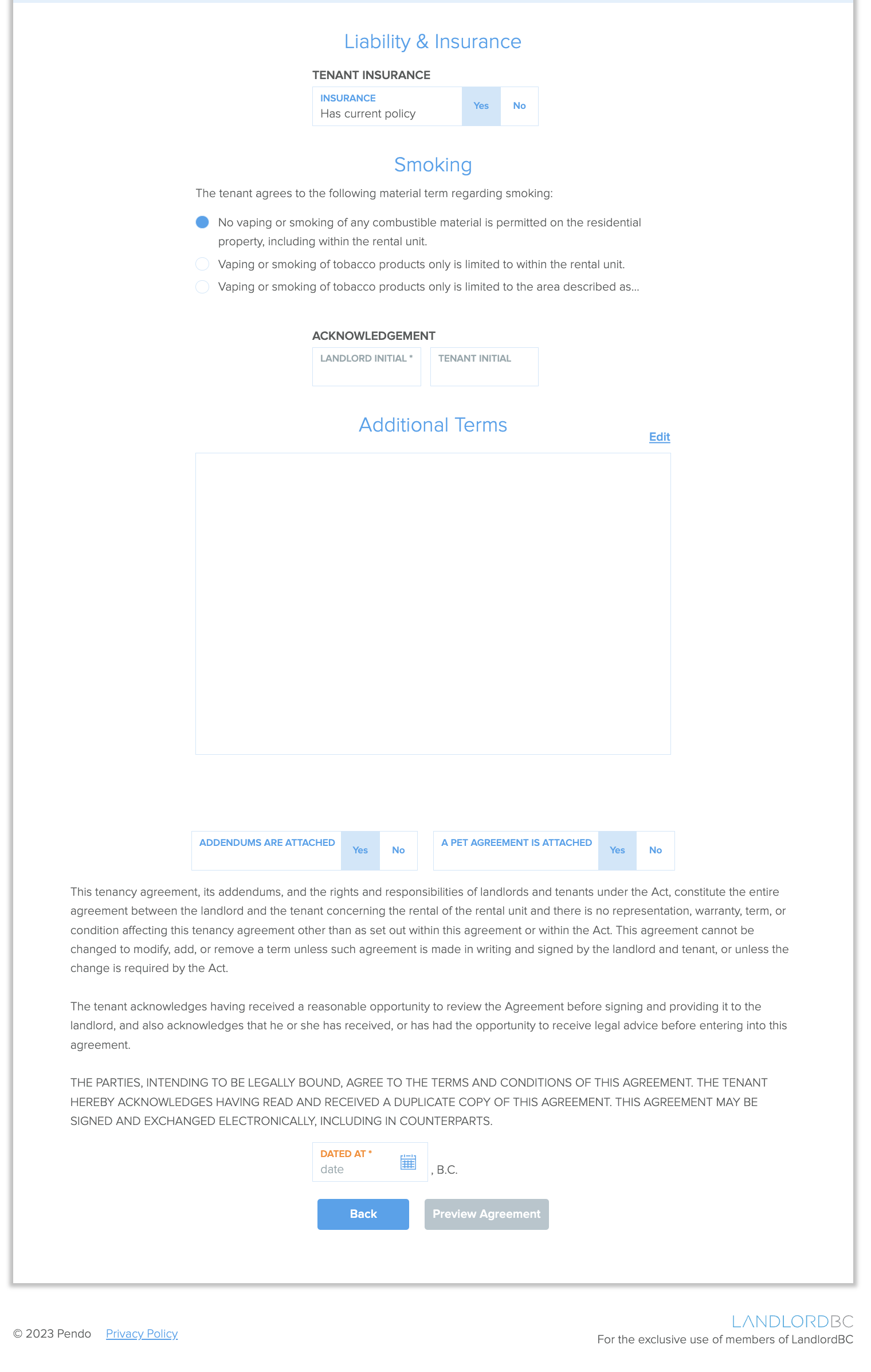
Section Six
Clicking on the Preview Agreement will allow you to view the lease prior to being sent to the tenant. Click here to see a sample.
At the bottom of the agreement, three options will be shown:
- Edit – go back and make changes
- Send – send agreement as is for signatures. Once the document is signed by all parties, it is fully executed and legally binding. It cannot be modified but you can create an addendum to add in additional clauses and have the tenant(s) sign that document to associate with the original leasePendo Lease Preview Before sent to Applicant.
- Print – save a copy of the unsigned document
